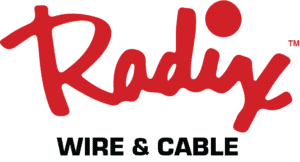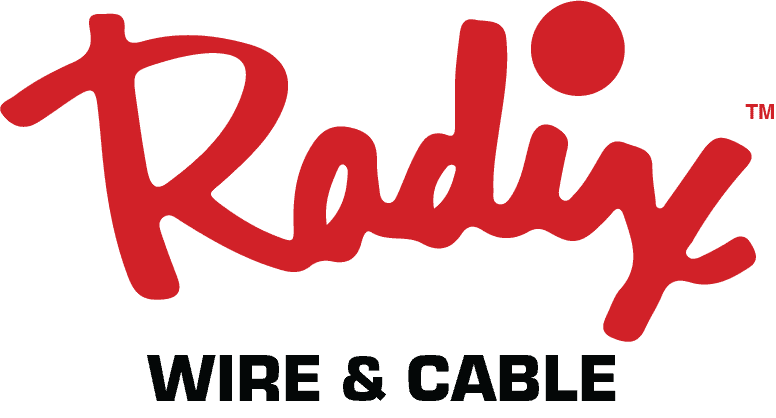Foreword
At Radix Wire Co., our resources are dedicated to one mission: creating solutions for quality high-temperature lead-wire products for applications at service temperatures as high as 1000C. We believe in designing and manufacturing well-engineered, uniform wire products and backing them with stringent quality control procedures, responsive customer service people, and conscientious follow-up efforts to meet your special product and information requirements.
The guide outlines how materials can be used in a “highest necessary” strategy to simplify wire selection decisions. Using such a strategy, it may be possible to select a single standard wire that encompasses several applications. At the very least, we hope that this Selection Guide can facilitate the dialogue that is so critical to specifying the best possible and most cost-effective wire product for your application.
Section 1 – Basic Elements of High-Temperature Insulated Wire
The five basic elements of high-temperature insulated wire are conductor, insulation, protective braid, jacketing and shielding. Not all elements are appropriate for each construction. Simpler constructions may require only a conductor and insulation. When severe service is expected at elevated temperatures, more complex constructions may be required. Each element should be discussed with the wire supplier.
Conductor
Critical conductor selection variables are a composition of conductor material, conductor diameter and stranding. Expected service temperature should be considered first because conductor materials vary in heat resistance. Next to be evaluated should be the conductor’s capacity to carry current without surpassing the temperature rating of the conductor and insulation. For further information regarding ampacities, please reference NEMA(insert table ID) or NEC (insert table ID) tables for applicable data.
Insulation
The purpose of primary insulation is to contain and channel the voltage. Materials selected for the primary insulation (thermoplastics, synthetic rubbers and mica) have good dielectric properties as well as heat resistance. For severe applications, it should be determined whether or not a secondary insulation may be required for protection against cutting, tearing or other damage. Because a primary insulation is usually selected for its dielectric strength, a choice may reflect some tradeoff of physical properties.
Braiding
Fiber glass is widely used in braided outer covers for limited mechanical protection. Glass braid almost always is saturated with an appropriate high-temperature finish to prevent fraying or moisture penetration and to improve fiber bonding.
Jacketing
Also called sheathing, jackets generally are extruded from thermoplastics or thermoset materials for mechanical, thermal, chemical and environmental protection. It is also used as a supplemental electrical insulation over metallic shields.
Shielding
Metal shielding, applied as a corrugated or flat tape or as a woven braid used to protect insulation from severe operating conditions. Additionally, it prevents power-generated interference from escaping to the surrounding environment. Metallic shielding also is commonly used in low-voltage communications wiring to protect signal integrity.
Section 2 – Application and Specification Guidelines
Defining Electrical Requirements
In selecting high-temperature insulated wire, the electrical requirements – operating voltage, conductor temperature rating and current-carrying capacity (ampacity) – must be met. The temperature rating of wire is determined by a combination of ambient heat and current-generated heat.
Current-generated heat is calculated by matching conductor material and diameter to service amperage. Ambient heat is the additional heat expected from the application. Due to the variations in heat dissipation through the insulation, and other factors involved, current-carrying capacity is a difficult selection variable. For this reason, product designers add safety margins. That is, they specify higher capacity conductors than theoretical calculations would indicate.
NOTE: See “Ampacity Ratings,” and “Temperature Derating” Tables under the “List of Tables”
Matching Environmental Conditions
After meeting electrical requirements for an application, a careful evaluation should be made of environmental conditions that can damage insulation and thus degrade or destroy circuit integrity.
Please review and consider the following conditions regarding application. Possible detriments to circuit integrity are not only limited to the following: ambient heat, moisture, abrasion, thermal stability, chemical attach, mechanical abuse, low temperature, flame resistance , ease of stripping, terminating and routing.
Section 3 – Conductor Selection
Temperature Ratings for Conductor Materials
Conductor* (Radix designations shown in parentheses)
Maximum Temperature Rating, °C
| Conductor* (Radix designations shown in parentheses) | Maximum Temperature Rating, °C |
|---|---|
| Bare Copper (BC)* | 200 |
| Tinned Copper (TC)* | 200 |
| Nickel-Plated Copper (NPC)** | 250 |
| Nickel-Coated Copper (NCC)** | 550 |
| Silver-Plated Copper (SPC) | 200 |
| Nickel-Plated Iron (NPI) | 250 |
| Nickel (NA) | 550+ |
* For 200 C rating, individual strands of bare or tinned copper must be 0.015-inch (AWG #26) or larger. AWG #30 (0.010-inch) cannot be rated at 200 C in bare or tinned copper. It must be protected with a nickel or silver-plating.
**NPC is 2% nickel, and NCC 27% nickel, by weight of conductor.
Current-Carrying Capacity
Current-carrying capacity (ampacity) is the current a conductor can carry before temperature – of conductor AND insulation – rises beyond a permitted limit. The following are key factors in determining ampacity:
Conductor Size and Material:
Conductivity of conductor materials varies widely. These variances affect current-carrying capacity. Also, as the conductor is reduced in diameter and mass, ampacity decreases.
Amperage:
As applied current rises, greater conductor heat is generated. A single AWG 16 copper conductor at 30 C ambient rises to 80 C with approximately 19 amperes of current; at 22 amps, the temperature at AWG 16 copper wire rises to about 90 C.
Ambient Temperature:
Electrical current is just one heat contributor. As the ambient temperature – the temperature of air surrounding the wire – rises, less current-generated heat is required to reach the temperature rating of the insulation. Thus, ampacity is governed also by contribution of ambient heat.
Insulation Type:
Heat dissipation through insulation varies with insulation type. The rate of dissipation affects total heat and, therefore, the ampacity. The dissipation problem becomes even more complicated when wire is enclosed in a tightly confined space.
For these reasons, assigning a current-carrying capacity to a conductor is an inexact process. Consequently, design engineers responsible for making such decisions may evaluate wire constructions empirically, using guidelines established by various standards such as the National Electrical Code. They also may deliberately de-rate a wire ampacity-rating estimate to achieve a greater margin of safety and extended service life of a product.
Section 4 – Insulation, Braiding, Jacketing, Shielding
Insulation
Primary Insulation – Primary insulation contains and channels the voltage. Placed next to the conductor as an extruded coating or tape wrap, its primary requirements are good dielectric – or synonymously, insulating-properties. Primary insulations are selected from several classes of materials: thermoplastics, including extruded and tape-wound Teflon*; synthetic rubbers; mica; and fiber glass.
Secondary Insulation – Primary insulation, usually selected for superior dielectric properties and heat resistance, sometimes may require a secondary insulation to protect against cutting, tearing or other physical abuse.
The secondary insulation may or may not have good dielectric properties, and is generally applied as a tape wrap or serving. Standard constructions that employ proven glass servings or fluorocarbon tapes achieve the greatest cost-effectiveness. Exotic materials (such as Kapton* film, which resists all chemicals except strong bases), may be used to meet special requirements of more unusual conditions.
Braiding
Fiber glass is the principal material used in braiding. To prevent fraying, improve moisture resistance and improve fiber bonding, wire manufacturers almost always saturate and finish braided fiber glass with high-temperature lacquers. Braided wires suit applications involving high heat.
For mechanical protection, an aramid material commonly referred to as K-fiber (Kevlar*) is used on large size single conductor silicone cables, or for the outer coating for multi-conductor high- temperature cables.
Jacketing
Jackets are protective covers extruded over insulation. Also called sheaths, jacketing materials resist abrasion, chemicals, and a range of environmental hazards.
A jacket provides additional mechanical protection to wire insulation, but may also serve as electrical insulation to isolate shield materials such as braided copper from the exterior environment.
To select the right jacket material – operating conditions and cost should be evaluated carefully with the aid of the wire supplier.
Shielding
Shielding is a metal cover – braided or served strands of tinned-copper, silver-plated copper, nickel-plated iron or stainless steel – that gives mechanical protection in harsh conditions.
Shielding refers also to protection for electronic circuits from electrically or electronically generated interference.
Shielding for high-temperature insulated wire is used to prevent electrical interference from escaping through the wire insulation to disrupt sensitive low-voltage electronic circuits or for mechanical protection.
NOTE:
* Teflon, Kapton, and Kevlar are registered trademarks of E.I. DuPont de Nemours & Company.
Closing
The following selection guide hopefully educated or highlighted specific requirements or questions in securing high temperature wire and cable. Creating solutions for quality high- temperature lead-wire products for applications at service temperatures as high as 1000C is what Radix Wire does best. For further inquiries contact us.


